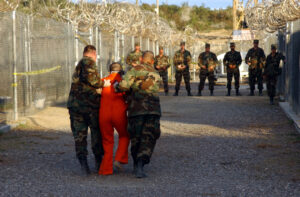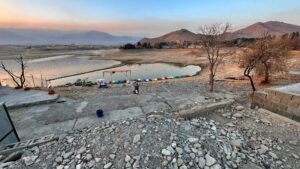German Police End March Envisioned as Far-Right Springboard
Three nationalist groups attempt to hold separate rallies in the city of Chemnitz over the Aug. 26 killing of a German citizen, allegedly by migrants from Syria and Iraq.CHEMNITZ, Germany — Police in eastern Germany halted an anti-migration protest march that emboldened far-right activists started Saturday hoping would launch a nationwide movement capable of challenging the political establishment.
A trio of nationalist groups held separate daytime rallies in the city of Chemnitz over the Aug. 26 killing of a German citizen, allegedly by migrants from Syria and Iraq. The two largest groups also organized a joint nighttime march, thinking a broader force might emerge from the display of unity and take hold.
If the number of people who attended is any gauge, the envisioned far-right movement was in the earliest of embryonic stages. It drew about 4,500 participants, Saxony state police reported before citing security concerns as the reason for ending the event early.
The demonstrators screamed and whistled angrily as officers broke up the protest.
The march was stopped several times along the way as counter-protesters blocked the route and the police officers deployed to keep them and the marchers apart flooded into the street. The counter-protesters numbered about 4,000, the state police said.
The opposing camps clashed in Chemnitz on Monday, the day after the fatal stabbing of the 35-year-old German citizen and the arrests of the migrants on suspicion of manslaughter. Scenes of vigilantes chasing foreigners in the city’s streets have shocked people in others parts of Germany since then.
Police, at times, were unable to control the earlier protests and clashes.
Leaders of the two groups that combined forces on Saturday night cultivated a different image for the “mourning march,” wearing dark suits and carrying white roses.
However, the mood at the event bringing together previously isolated clusters of nationalists — from lawmakers to Hitler-saluting skinheads — darkened as the sun set. People from both ends of the political spectrum could be seen drinking beer and shouting slurs at police.
The tension in the air reflected the polarization over Germany’s ongoing effort to come to terms with an influx of more than 1 million refugees and migrants seeking jobs since 2015.
The right blames Chancellor Angela Merkel’s decision to allow in hundreds of thousands of asylum-seekers from war-torn countries like Syria, Iraq and Afghanistan for multiple problems. Some far-right supporters argued before the killing in Chemnitz that migrants are responsible for an increase in serious crimes, especially attacks on women.
The anti-migrant sentiment has been particularly strong in Saxony state, traditional strongholds of groups that sought to inspire a nationwide movement on Saturday night: the Patriotic Europeans Against the Islamization of the West, or PEGIDA, and the far-right Alternative for Germany party, which has won seats in federal and state parliaments with an anti-Muslim platform.
While the share of foreigners residing in Saxony remains below Germany’s national average and displays of Nazi symbols are outlawed across the shame-marked country, far-right sympathizers mobilized with exceptional speed on the night of the Chemnitz slaying and the days after.
German Justice Minister Katarina Barley said Saturday that authorities should investigate the role of networks from the radical far right in spearheading the week’s protests.
“We do not tolerate that right-wing extremists infiltrate our society,” Barley told weekly newspaper Bild am Sonntag. “It’s about finding out who’s behind the mobilization of far-right criminals.”
Local police appeared to have been caught unprepared when the slaying triggered the protests, which attracted crowds openly engaging in Nazi veneration and devolved into violence.
The protests were sparked by a fatal stabbing early Sunday morning of a 35-year-old German man, Daniel Hillig. Two asylum-seekers, a 22-year-old Iraqi and a 23-year-old Syrian, have been arrested on suspicion of manslaughter.
German Interior Minister Horst Seehofer, known for his anti-migrant stance, said Saturday that he understood why “the people in Chemnitz and elsewhere are upset about the brutal killing” but added “there’s no excuse for violence,” Funke Media Group reported.
“We need a strong state and we have to do everything politically to overcome the polarization and division of our society,” Seehofer stressed.
While anti-migrant protests took place in Germany before, especially during the early 1990s, a strong and vocal opposition usually was there to provide a counterforce. Artists organized concerts to raise awareness, and ordinary citizens lined up in miles-long human chains to protest violence against newcomers.
Chemnitz, a city known for its hardened neo-Nazi scene, at first attracted a comparatively weak response to the recent anti-migrant activity. Some 70 left-leaning and pro-migrant groups organized the “Heart not Hatred” rally that got in the way of Saturday’s far-right march.
“I’ve a lot of experience with far-right protests in Chemnitz,” Tim Detzner, a member of the Left Party in Chemnitz, said, noting that the street riots this week “reached a level of aggression, brutality and willingness to use violence that we haven’t known before.”
___
Grieshaber reported from Berlin. Frank Jordans contributed from Berlin.
Your support matters…Independent journalism is under threat and overshadowed by heavily funded mainstream media.
You can help level the playing field. Become a member.
Your tax-deductible contribution keeps us digging beneath the headlines to give you thought-provoking, investigative reporting and analysis that unearths what's really happening- without compromise.
Give today to support our courageous, independent journalists.






You need to be a supporter to comment.
There are currently no responses to this article.
Be the first to respond.